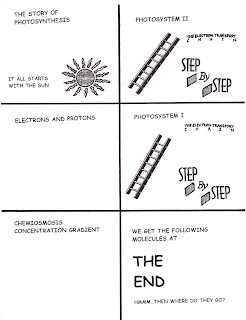I use storyboarding to teach the processes of protein synthesis, photosynthesis, and respiration. I introduce my students to the concept of storyboarding by showing them this American Film Institute video, which can be found on these two web sites:
http://www.youtube.com/watch?v=pWPjjoOFIu8
or
http://www.afi.com/education/screened/demo/screened_tables_student.aspx
However, the above links have now become unavailable. I'm leaving them in there for reference.
But I found another website that has the video!!!
https://app.schooltube.com/video/d2525f42fd3809f3dabd/Storyboarding%20(AFI's%20Lights,%20Camera,%20Education!)
I did find a website with a video about storyboarding on this website, even though it is not nearly as good as the original, I does give students ideas about drawing out stories as pictures or cartoons.
http://uwsslec.libguides.com/c.php?g=187016&p=1236350
Here are the hand outs for Act II of Photosynthesis - The Calvin Cycle (see example key at the bottom of this post):
Storyboard - Act II - The Calvin Cycle of Photosynthesis
NAME__________________________________________________________________
DIRECTIONS FOR STORYBOARD ACTIVITY—PHOTOSYNTHESIS—THE CALVIN-BENSON CYCLE
1. DRAW A RECTANGLE AROUND EACH OF THE FOUR STEPS IN THE
PROPER SEQUENCE SO THAT THE READER CAN FOLLOW THE STORY.
1 PT.
2. PUT IN AT LEAST FOUR FACTS THAT HELP EXPLAIN PHOTOSYNTHESIS.
1 PT. EACH
3. ON YOUR STORYBOARD, USE THESE VOCABULARY WORDS AT LEAST
ONCE. MAKE THEM BOLD.
STROMA
CARBON FIXATION
ATP
NADPH
GLUCOSE
1 PT. EACH
4. DEFINE THE ABOVE VOCABULARY WORDS ON THE BACK OF YOUR STORYBOARD.
1 PT.EACH
5. IN THE CENTER OF THE STORYBOARD WRITE DOWN THE TOTAL
NUMBER OF OUTPUT CARBONS AT EACH STEP OF THE CYCLE.
1 PT.
6. COLOR THE CARBON “ATOMS” BLACK.
1 PT.
7. COLOR THE ARROW YELLOW, WHERE THE CHEMICAL ENERGY MOLECULES OF ATP
ARE USED IN THE CYCLE. ALSO, COLOR THE OTHER ARROW YELLOW, WHERE THE
MOLECULES OF ATP AND NADPH ARE USED.
1 PT.
8. COLOR ALL OTHER ARROWS BLACK, TO SHOW THE CYCLING OF THE
ORGANIC CARBON MOLECULES.
1 PT.
9. SHOW, ON THE STORYBOARD, AT LEAST TWO POLYMERS THAT ARE
MADE, IN THE PLANT, FROM THE GLUCOSE MOLECULES.
1 PT.
10. DRAW OR PASTE A PICURE OF THE STRUCTURE OF A GLUCOSE
MOLECULE ON YOUR STORYBOARD.
Here is an example of a completed storyboard:

The storyboard for the light reactions of photosynthesis is in the previous post of this blog. When you are through with your storyboards, then you should listen to and sing the Photosynthesis Song; there is a link to it on the right column of the Science Tutor blog in the "links" section. In my next post, I will include the storyboard for cellular respiration, and then I will post the storyboards for protein synthesis.
Here is a link for some lecture notes on the topic:
http://chemistry.about.com/od/lecturenotesl3/a/photosynthesis_4.htm
Another great teaching link:
http://ed.ted.com/lessons/nature-s-smallest-factory-the-calvin-cycle-cathy-Symington
Here are some examples of books that utilize graphics to teach:
http://www.powells.com/book/manga-guide-to-molecular-biology-9781593272029/2-2
Also, Larry Gonick's cartoon guides are fun and informative:
http://www.powells.com/SearchResults?kw=title:larry%20gonick
For the storyboarding graphic organizers you may visit my other posts:
http://cavalierscience.blogspot.com/2010/06/protein-synthesis-graphic-organizer.html
http://cavalierscience.blogspot.com/2010/06/cellular-respiration-graphic-organizer.html
http://cavalierscience.blogspot.com/2010/06/photosynthesis-calvin-cycle-graphic.html
http://cavalierscience.blogspot.com/2010/06/photosynthesis-light-reactions-graphic.html
If you find links in my blog that do not work, please let me know by submitting a comment. I would like to keep everything up-to-date and relevant.



















